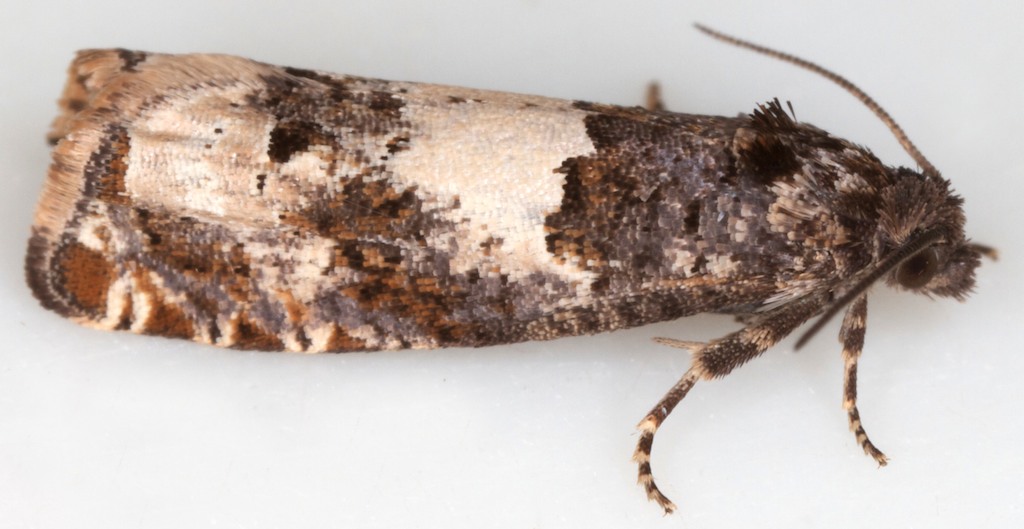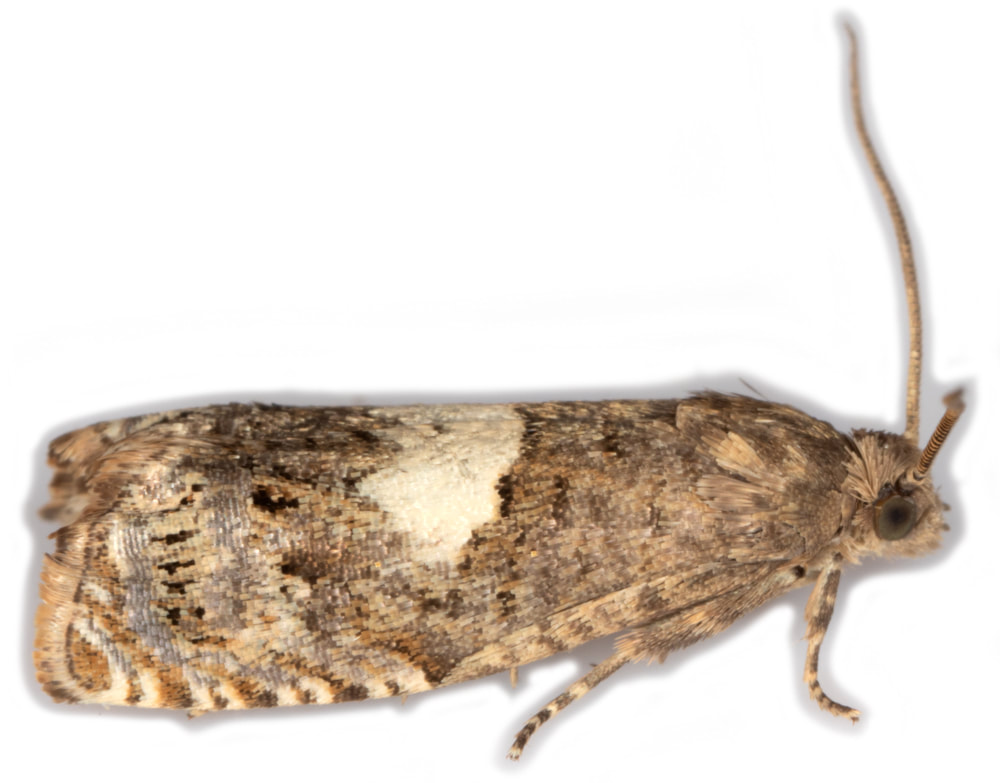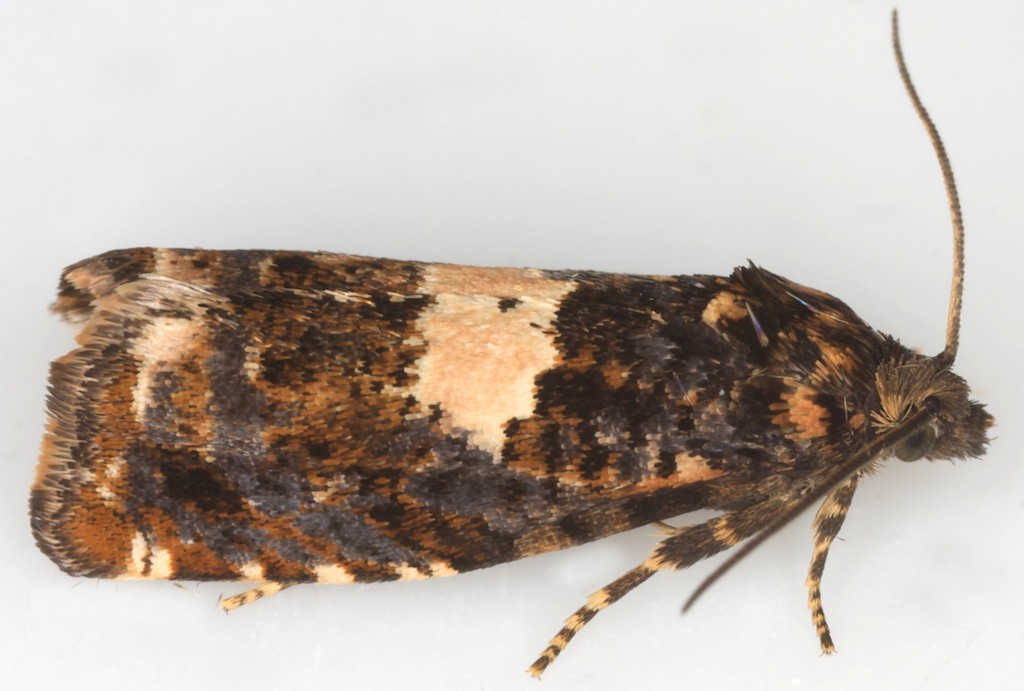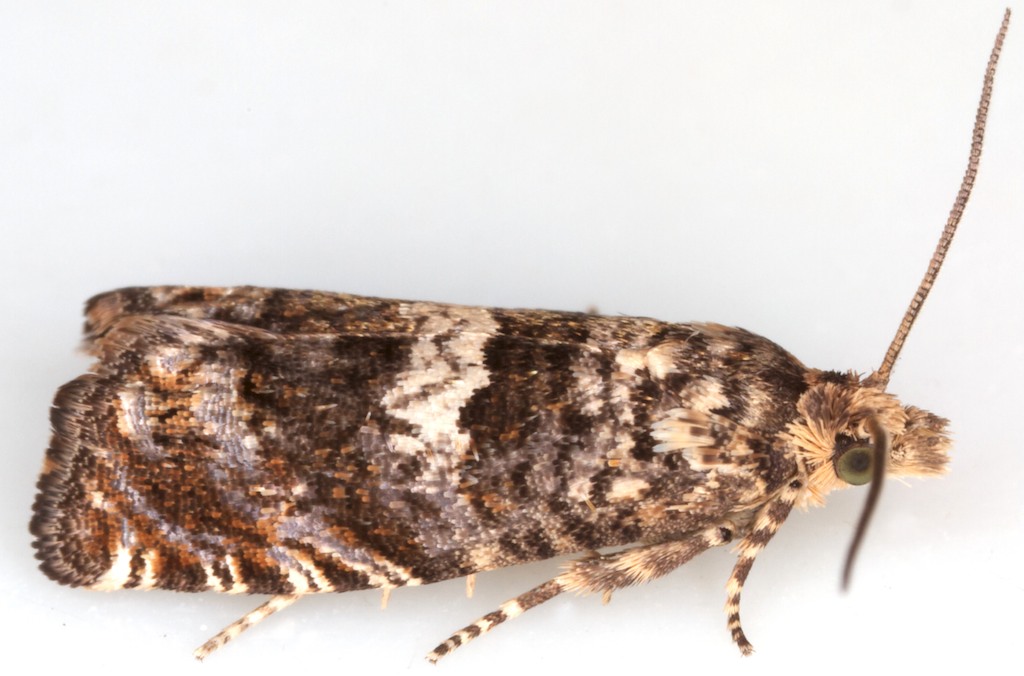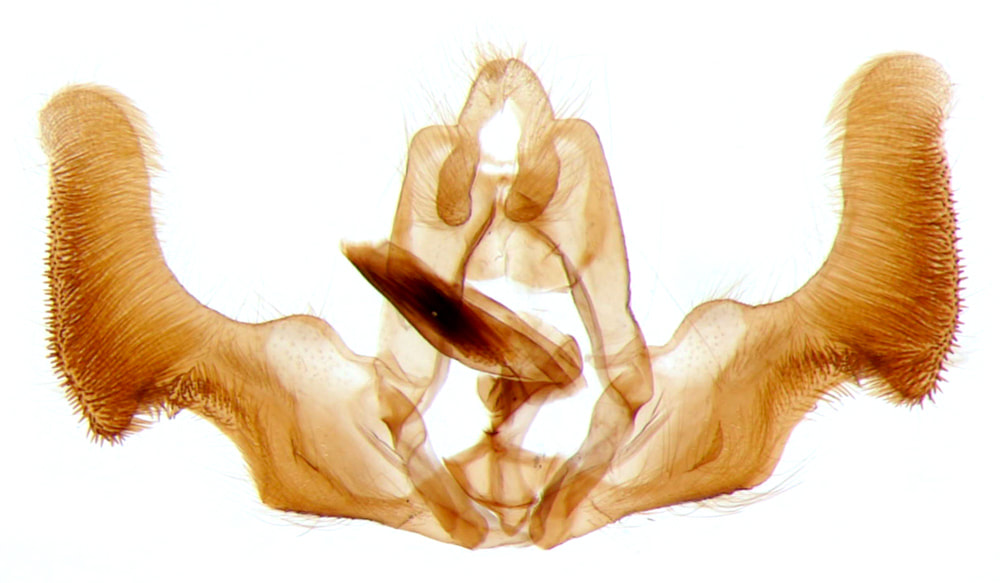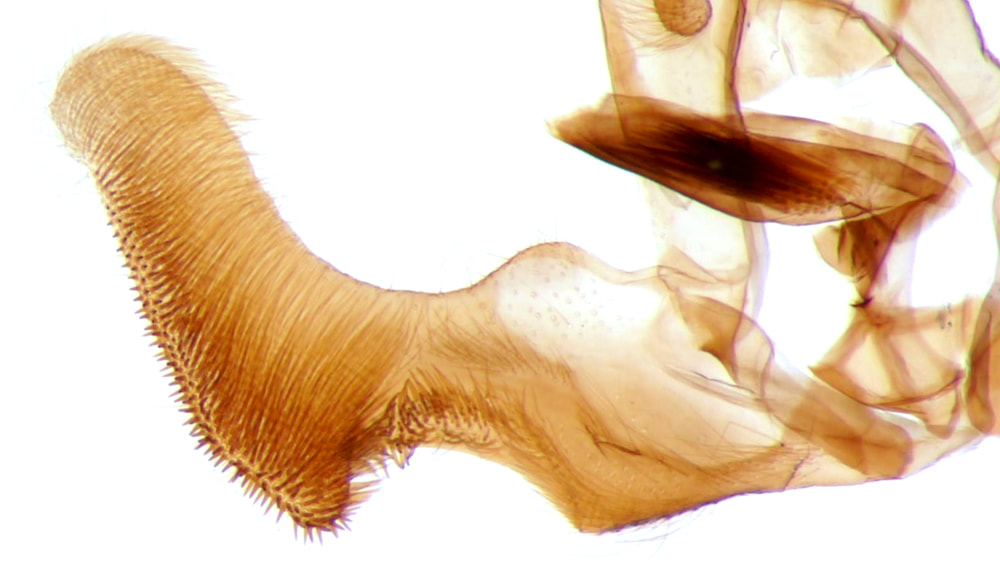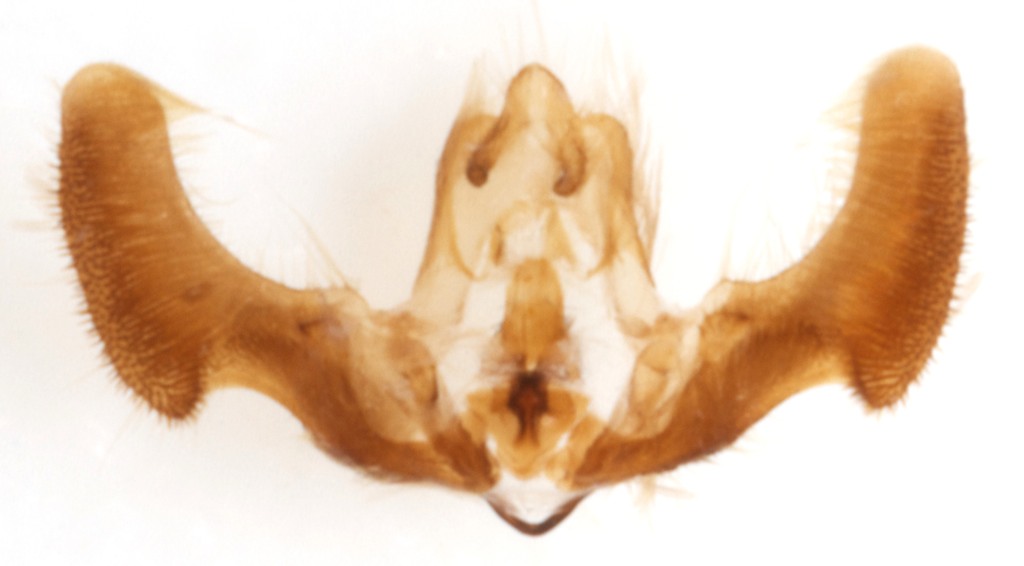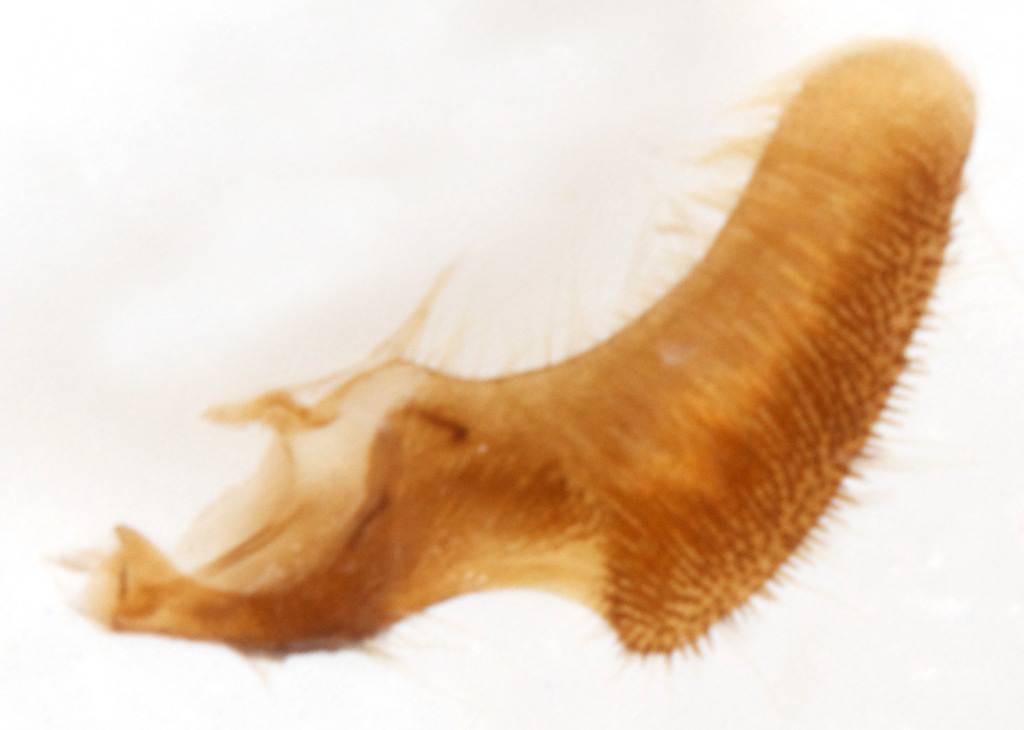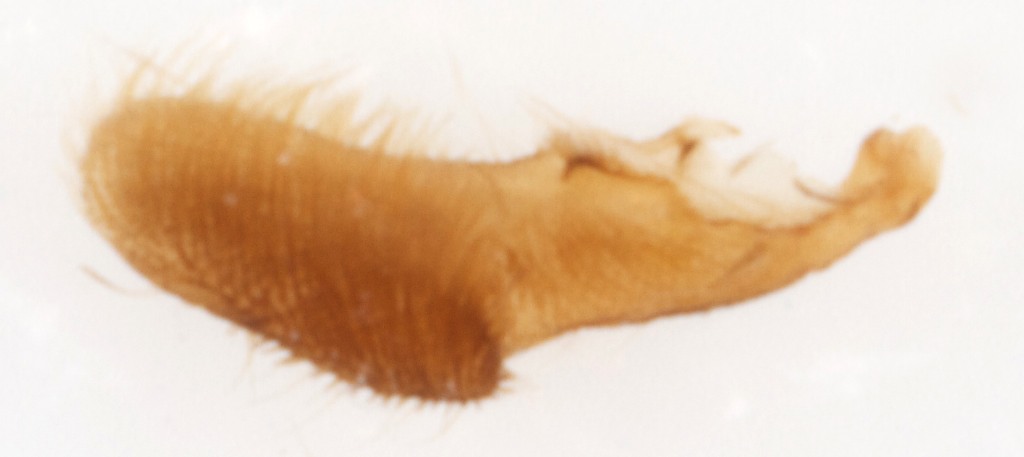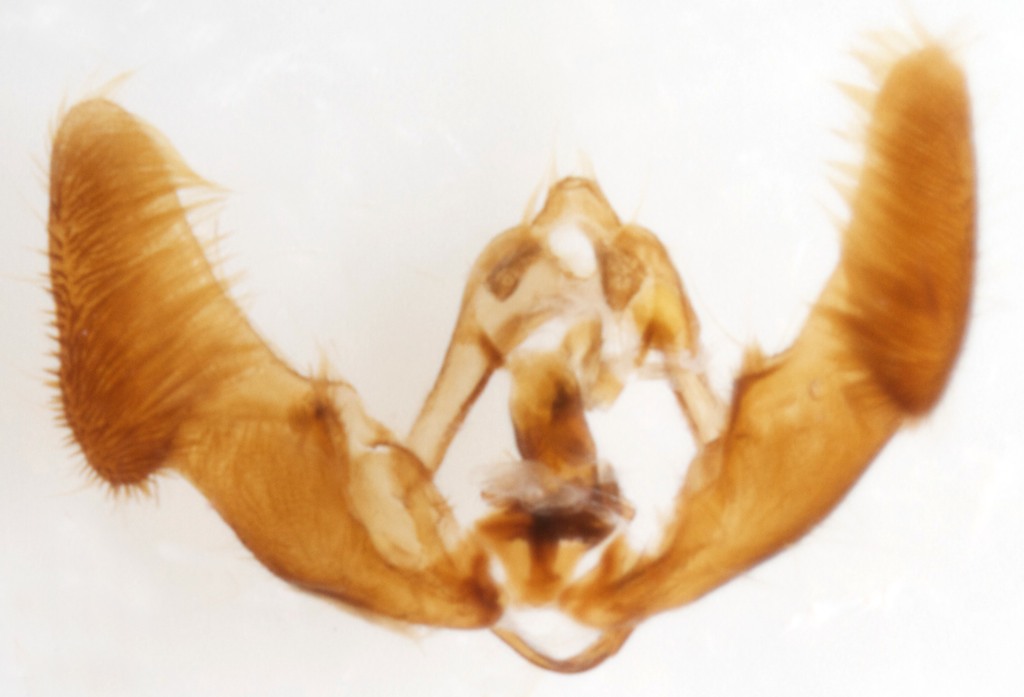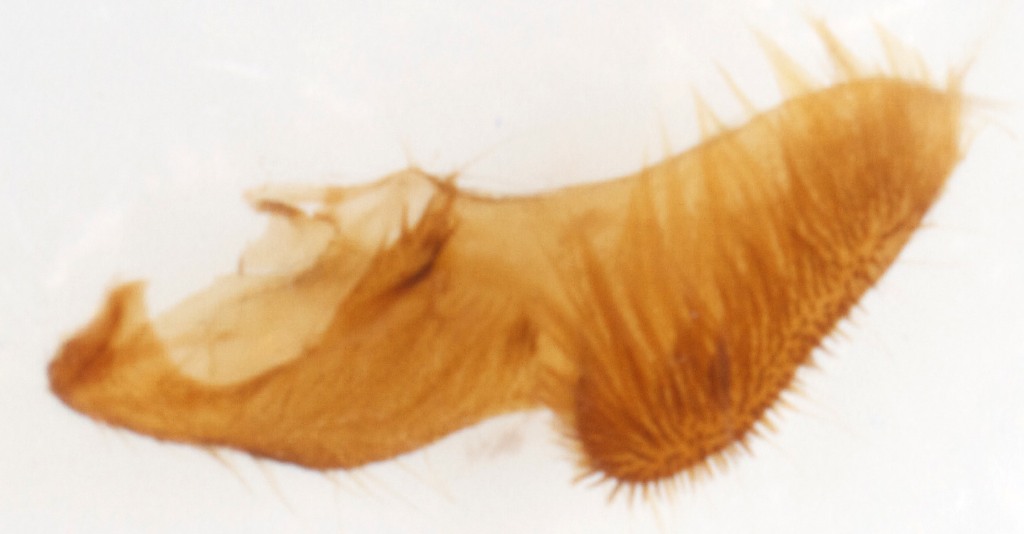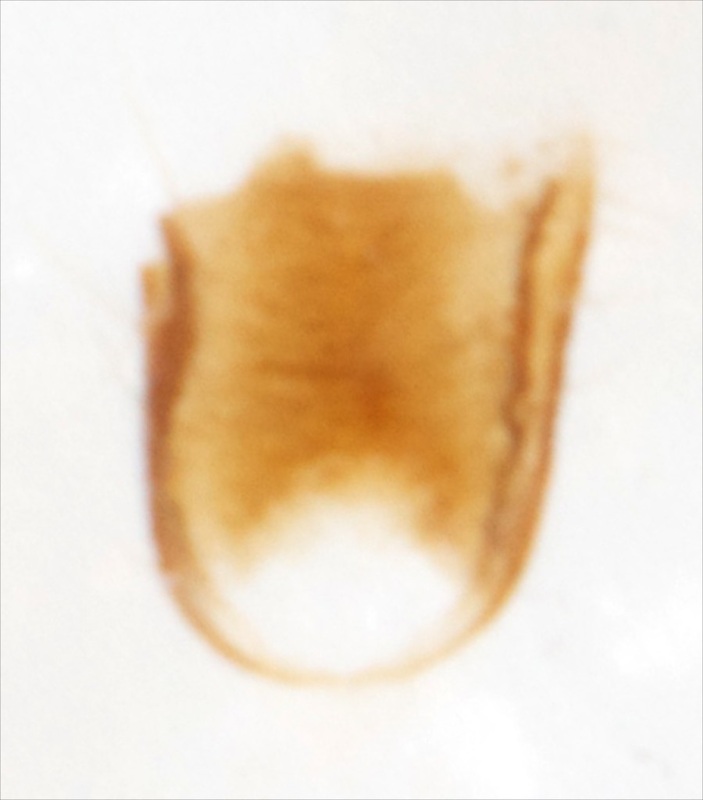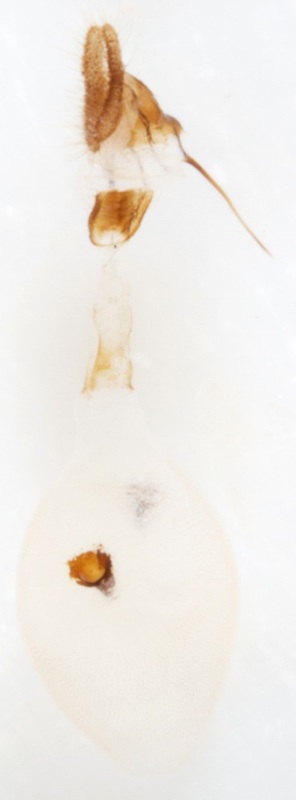|
Epiblema scutulana, E.cirsiana, E.cnicicolana, E.sticticana & E.costipunctana
|
This group of Epiblema species are characterised by a subquadrate white central dorsal blotch. This group differs from the Notocelia trimaculana group in having a well-developed median fascia more or less connected to the pre-tornal spot. There is variation within the group in the extent of a white patch distal to the pre-tornal mark and in the exact colour of the forewing markings. N.tetragonana (ws 13-16mm) could also be confused with this group but should be distinguished by its dark forewing except for the clear cream-white dorsal blotch, blue-grey striae traversing the apical part of the forewing and dark fuscous hindwing.
Key to forewing features:
Large white patch, of similar size to the medio-dorsal blotch, in the torno-apical region; hw grey lighter towards base > male E.scutulana
(all others in the group show a small or no white apical patch and a fuscous hw)
Medio-dorsal blotch with one or two weak strigulae across it > E.costipunctana
Although there are features, listed below, that may suggest certain species - the rest of this group requires genital dissection for confident ID.
Key to forewing features:
Large white patch, of similar size to the medio-dorsal blotch, in the torno-apical region; hw grey lighter towards base > male E.scutulana
(all others in the group show a small or no white apical patch and a fuscous hw)
Medio-dorsal blotch with one or two weak strigulae across it > E.costipunctana
Although there are features, listed below, that may suggest certain species - the rest of this group requires genital dissection for confident ID.
E.scutulana (ws 18-23mm) male has a substantial white patch distal to the coalesced median fascia-pre-tornal spot and grey hw lighter towards base.
E.costipunctana (ws 13-18) shows weak strigulae across the white medio-dorsal blotch
E.cnicicolana (ws 14-16mm) is rare, confined to S.England and S.Wales and may be suspected from its dark brown forewing colouration. Its medio-dorsal blotch is also stated to extend further across the wing than in its congeners.
E.sticticana (ws 15-20mm) may be suspected from light brown forewing colouration
E.cirsiana (ws 12-23mm) and female E.scutulana are inseperable from each other without genital dissection which is also required for confident separation from E.cnicicolana and E.sticticana.
E.costipunctana (ws 13-18) shows weak strigulae across the white medio-dorsal blotch
E.cnicicolana (ws 14-16mm) is rare, confined to S.England and S.Wales and may be suspected from its dark brown forewing colouration. Its medio-dorsal blotch is also stated to extend further across the wing than in its congeners.
E.sticticana (ws 15-20mm) may be suspected from light brown forewing colouration
E.cirsiana (ws 12-23mm) and female E.scutulana are inseperable from each other without genital dissection which is also required for confident separation from E.cnicicolana and E.sticticana.
Key to male genitalia (See Epiblema for valval nomenclature)
Sacculus with distinctly angular ventral margin > E.sticticana (fairly evenly rounded in all other Epiblema species except E.foenella)
Pulvinus* present; horn very small > E.costipunctana
Cucullus short, lateral margin indented > E.tetragonana ^
Dorsal margin of valva shallowly curved (angle formed between long axis of sacculus and long axis of cucullus distinctly obtuse)
> E.scutulana/E.cirsiana (these two are indistinguishable)
Dorsal margin of valva steeply curved (angle formed between long axis of sacculus and long axis of cucullus almost 90 deg) > E.cnicicolana ^
* a semicircular bristly pad adjacent to the horn; ^ based on drawings in Pierce & Metcalfe
Sacculus with distinctly angular ventral margin > E.sticticana (fairly evenly rounded in all other Epiblema species except E.foenella)
Pulvinus* present; horn very small > E.costipunctana
Cucullus short, lateral margin indented > E.tetragonana ^
Dorsal margin of valva shallowly curved (angle formed between long axis of sacculus and long axis of cucullus distinctly obtuse)
> E.scutulana/E.cirsiana (these two are indistinguishable)
Dorsal margin of valva steeply curved (angle formed between long axis of sacculus and long axis of cucullus almost 90 deg) > E.cnicicolana ^
* a semicircular bristly pad adjacent to the horn; ^ based on drawings in Pierce & Metcalfe
Female genitalia:
Provisional key:
One signum at least 5x broader than the other = E.cnicicolana
Ostium simple, periostial plate poorly developed = E.sticticana
Periostial plate with edges diverging posteriorly, posterior margin of ostium sharply defined = E.costipunctana
Periostial plate with robust nearly parallel edges = E.cirsiana
Periostial plate with weak nearly parallel edges = E.scutulana
E.scutulana/costipunctana/cirsiana are shown at Dissection Group; Pierce and Metcalfe describe and illustrate E.scutulana (as E.pflugiana), E.cnicicolana (and E.littoralana which is synonymous with E.cnicicolana), E.costipunctana (as E.trigeminana) and E.sticticana (as E.brunnichiana). They describe but do not illustrate E.cirsiana (as E.circiana) and comment that they were unable to separate E.scutulana/cirsiana with any confidence. Their descriptions are as follows:
E.cnicicolana: Ovipositor narrow, sides incurved; ostium rounded, sides spined; DB a short collar; signa, one narrow, pointed the other very wide.
(E.littoralana: Ovipositor narrow, sides not incurved; ostium more oval, spined above and at sides; signa, one narrow, pointed the other very wide.)
E.scutulana: Ovipositor flattened, narrow, rods short, stout. E.cirsiana: Ovipositor rods long, slender
E.costipunctana: Dark ostium edge continued across the plate. E.sticticana: Ostium simple, constricted before DB.
The signa (one narrow, pointed, the other very wide) should distinguish E.cnicicolana
The illustration of E.sticticana shows a weak parallel-sided periostial plate with a distinct constriction at its junction with the DB; it also shows two similarly-sized signa - these features should allow identification (if they reflect reality).
In the remaining species one signum is larger than the other but this difference is far less marked than in E.cnicicolana.
E.costipunctana should be identifiable on external features; I have no idea what P&Ms description means - it does not seem to describe anything that can be seen in the illustration in P&M or in the image at Dissection Group.
In comparing E.costipunctana/E.cirsiana the key difference is in the periosteal plate which is more parallel-sided and more robustly edged in E.cirsiana and with a more sharply defined posterior ostial margin in E.costipunctana.
The difference between E.scutulana/cirsiana is not illustrated in P&M and I do not know what they mean by 'rods'. In comparing the images at Dissection Group it looks as though the margins of the periostial plate are less robust in E.scutulana but the image quality is less good for E.scutulana. An obvious difference between the images is seen at the DB/CB junction - in E.cirsiana the DB gradually expands as it merges with the CB; in E.scutulana the DB is narrow throughout and the junction with the CB is well-defined. If this obvious difference is real it seems likely that P&M would have noticed it - so perhaps this feature is variable in both species?
Provisional key:
One signum at least 5x broader than the other = E.cnicicolana
Ostium simple, periostial plate poorly developed = E.sticticana
Periostial plate with edges diverging posteriorly, posterior margin of ostium sharply defined = E.costipunctana
Periostial plate with robust nearly parallel edges = E.cirsiana
Periostial plate with weak nearly parallel edges = E.scutulana
E.scutulana/costipunctana/cirsiana are shown at Dissection Group; Pierce and Metcalfe describe and illustrate E.scutulana (as E.pflugiana), E.cnicicolana (and E.littoralana which is synonymous with E.cnicicolana), E.costipunctana (as E.trigeminana) and E.sticticana (as E.brunnichiana). They describe but do not illustrate E.cirsiana (as E.circiana) and comment that they were unable to separate E.scutulana/cirsiana with any confidence. Their descriptions are as follows:
E.cnicicolana: Ovipositor narrow, sides incurved; ostium rounded, sides spined; DB a short collar; signa, one narrow, pointed the other very wide.
(E.littoralana: Ovipositor narrow, sides not incurved; ostium more oval, spined above and at sides; signa, one narrow, pointed the other very wide.)
E.scutulana: Ovipositor flattened, narrow, rods short, stout. E.cirsiana: Ovipositor rods long, slender
E.costipunctana: Dark ostium edge continued across the plate. E.sticticana: Ostium simple, constricted before DB.
The signa (one narrow, pointed, the other very wide) should distinguish E.cnicicolana
The illustration of E.sticticana shows a weak parallel-sided periostial plate with a distinct constriction at its junction with the DB; it also shows two similarly-sized signa - these features should allow identification (if they reflect reality).
In the remaining species one signum is larger than the other but this difference is far less marked than in E.cnicicolana.
E.costipunctana should be identifiable on external features; I have no idea what P&Ms description means - it does not seem to describe anything that can be seen in the illustration in P&M or in the image at Dissection Group.
In comparing E.costipunctana/E.cirsiana the key difference is in the periosteal plate which is more parallel-sided and more robustly edged in E.cirsiana and with a more sharply defined posterior ostial margin in E.costipunctana.
The difference between E.scutulana/cirsiana is not illustrated in P&M and I do not know what they mean by 'rods'. In comparing the images at Dissection Group it looks as though the margins of the periostial plate are less robust in E.scutulana but the image quality is less good for E.scutulana. An obvious difference between the images is seen at the DB/CB junction - in E.cirsiana the DB gradually expands as it merges with the CB; in E.scutulana the DB is narrow throughout and the junction with the CB is well-defined. If this obvious difference is real it seems likely that P&M would have noticed it - so perhaps this feature is variable in both species?
Female information added 21/08/2014
